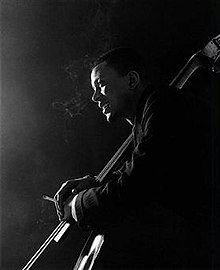Doug Watkins
| Doug Watkins | |
|---|---|

Watkins c. 1950
|
|
| Background information | |
| Born |
March 2, 1934 Detroit, Michigan, United States |
| Died | February 5, 1962 (aged 27) |
| Genres | Jazz |
| Occupation(s) | Musician, composer |
| Instruments | Double bass, cello |
| Years active | 1950–1962 |
| Labels | Blue Note, Prestige, Atlantic |
| Associated acts | Art Blakey, Horace Silver, Sonny Rollins, Hank Mobley, Charles Mingus, Red Garland, Donald Byrd, Kenny Burrell, Lee Morgan |
Douglas Watkins (March 2, 1934 – February 5, 1962) was an American jazz double bassist from Detroit.
An original member of the Jazz Messengers, he later played in Horace Silver's quintet and freelanced with Gene Ammons, Kenny Burrell, Donald Byrd, Art Farmer, Jackie McLean, Hank Mobley,Lee Morgan, Sonny Rollins, and Phil Woods among others.
Some of Watkins' best-known work can be heard when as a 22-year-old he appeared on the 1956 album, Saxophone Colossus by tenor saxophonist Sonny Rollins, with Max Roach and Tommy Flanagan. From that session, the tunes "Blue Seven" and "St. Thomas," especially, have become revered not only as evidence of Rollins' original genius but as fine examples of Watkins' work.
According to Horace Silver's autobiography, Let's Get to the Nitty Gritty, Watkins, along with Silver, later left Art Blakey's Jazz Messengers because the other members of the band at the time (Kenny Dorham, Hank Mobley and Blakey) had serious drug problems, whereas Watkins and Silver were tired of being harassed and searched by the police every time they went to a gig in a new city and club.
In 1958 Watkins would join Donald Byrd for a European tour, taking up extended residence at Le Chat Qui Pêche, a jazz club on Paris' Left Bank. Along with Byrd, tenor saxophonist Bobby Jaspar, pianist Walter Davis, Jr. and drummer Art Taylor, Watkins made two albums with Byrd during this time, one recorded in the club and another at a formal concert featuring Byrd's quintet.
...
Wikipedia
